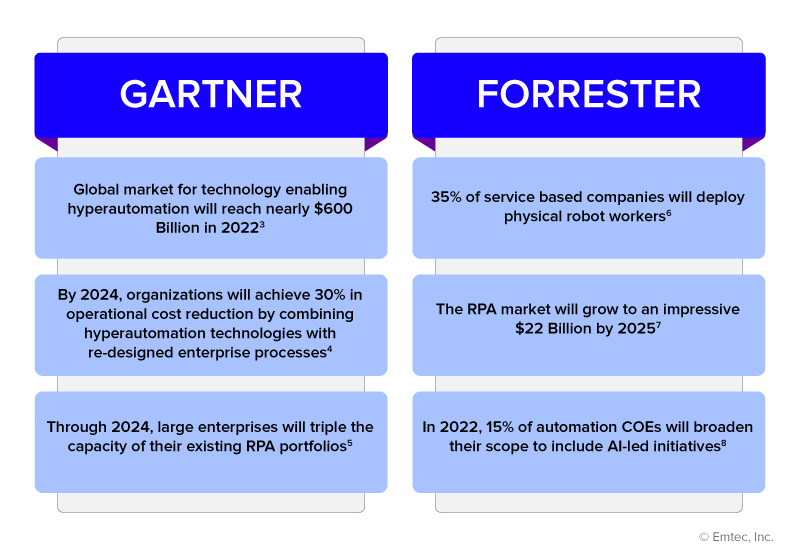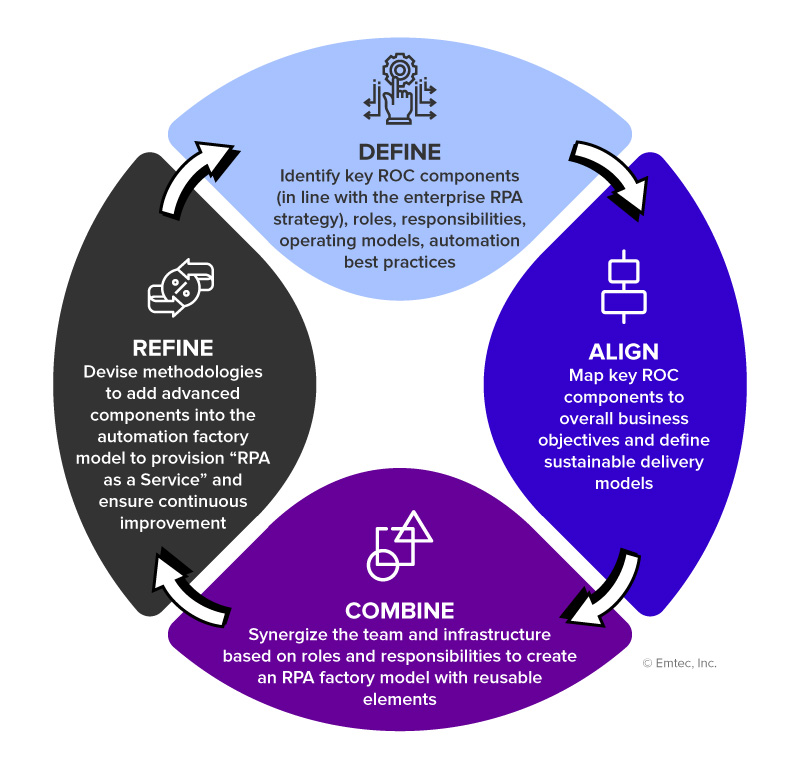More and more organizations are leveraging Robotic Process Automation (RPA) to streamline critical processes and increase efficiencies. McKinsey predicts that disruptive and emerging technologies such as RPA will have a potential economic impact of about $6.7 Trillion by 20251. According to Gartner, an increasing number of organizations will shift to digital-first business models and cloud-native operations in 2022, accelerating the pace of RPA and creating fully automated value chains2. The additional inclusion of Artificial Intelligence, Machine Learning, and Natural Language Processing technologies within RPA initiatives will further boost digital transformation across the enterprise.

It’s official – bots are here to stay. However, RPA doesn’t end with bot development and deployment. A critical and often overlooked element is what happens after bots are implemented. Regular and ongoing maintenance of bots is crucial to ensure smooth performance. This is where a Robotic Operations Center (ROC) comes into play.
This blog highlights the criticality of devising a strong bot maintenance and optimization strategy before process automation planning begins, and the downside of not having a sound bot maintenance plan in place. It also addresses the tricky question of “In-house vs Outsource”, highlighting the many benefits of outsourcing ongoing bot management to a trusted technology services provider.
A comprehensive strategy for RPA factors in people, process, and technology
Effective enterprise automation initiatives need a strong strategy that focuses on successfully integrating three key components – people, process, and technology – to ensure measurable business outcomes. For any RPA strategy to be efficient, organizations need to –
- Define the overall vision for the automation strategy – what are the organizational expectations from RPA initiatives?
- Gather the requisite skills for automation – what skills are required, what are the current in-house capabilities, how to acquire skills missing in the internal teams?
- Delegate the management of enterprise automation initiatives – should RPA be managed through an in-house Center of Excellence (CoE), or should this function be outsourced to a skilled third-party vendor?
- Identify and measure Key Performance Indicators (KPIs) – how to measure the success of the enterprise RPA strategy?
A sound RPA strategy serves as a blueprint for scalability of future automation projects, as well as preventing wastage of critical resources including money, time, and efforts.
How can a Robotic Operations Center (ROC) help maximize your RPA investments?
Enterprise RPA initiatives are geared towards identifying the right tool, selecting an experienced implementation partner, and establishing strong governance models to ensure seamless bot deployment. However, it is important to continuously monitor and track bot performance to prevent downtime, mitigate risk, and identify opportunities for bot optimization through a structured Robotic Operations Center (ROC).
In its simplest definition, an ROC is an extension of the RPA Center of Excellence (CoE) and is usually led by a hybrid IT + operations team. The ROC empowers IT and DevOps teams by monitoring bot performance 24×7 with continuous support and maintenance to resolve incidents and mitigate inherent risk in production. The ROC ensures that bots seamlessly deliver the business value expected from enterprise automation projects while complying with organizational frameworks and rulesets. Here are the top reasons why you need a dedicated Robotic Operations Center:
- Increases ROI from enterprise RPA initiatives: The ROC ensures bots are consistently monitored and optimized, helping ensure expected ROI is achieved from strategic automation initiatives. Once initial process automation pilots are successful, increased demand for additional automation RPA use cases will inevitably arise. The ROC serves as a scalable resource for management of an expanding suite of bots across the enterprise.
- Allows end-to-end visibility of automation projects: Often, enterprise RPA initiatives across geographically distributed lines of business are quite complex and increase overheads. The ROC has total visibility into the various organizational functions and facilitates the creation of a centralized scenario of the RPA landscape. This enables the prioritization of critical use cases for future automation projects based on overall business goals.
- Ensures adoption of robust cybersecurity protocols: RPA operations experts within the ROC are accountable to provision and maintain bot credentials in secure password vaults. Assigning multiple roles to bots violates the NIST 800-123 principle of least privileges9 and risks exposing the enterprise to cybersecurity threats. ROC security experts create strategies to mitigate risk and ensure that all cybersecurity protocols are in place.
- Strengthens accountability and communication among RPA stakeholders: The team structure in the ROC follows pre-defined guidelines that outline key responsibilities and tasks for each team member. This robust structure and accountability model effectively tracks the performance of enterprise RPA implementations and strengthens communication among key stakeholders. The result is a streamlined and powerful process automation engine that brings higher operational efficiency and tangible ROI.
Why you should build a strong ROC strategy before implementing process automation
For RPA to be successful, you need to have a strategy in place for ROC – prior to making any automation investments. A solid enterprise ROC strategy will lay the foundation to leverage automation capabilities effectively within your organization. The ROC will help you identify use cases, provide recommendations for the smooth functioning of bots, guarantee bot governance across all levels, and offer technical training and workshops for all key stakeholders. It will enable you to create an enterprise automation library to identify potential candidates for process automation, evaluate lessons learnt from previous automation attempts, and build RPA best practices. Most importantly, an ROC helps you establish a culture of success for your automation initiatives. It provides the critical support needed to ensure your automation initiatives are successful now and into the future as your business, processes, systems, and people inevitably change over time.
The following process can help you create an effective ROC strategy that factors in people, process, and technology to deliver measurable value to the business:

The downside of not having a sound ROC strategy while planning for RPA
The success of RPA rests solely on the foundation of a good bot monitoring and optimization strategy. What happens when you lack a strategy for ROC? Besides a very haphazard enterprise automation implementation, here are some of the common pitfalls:
- Change management issues in bot operations
- Lack of quality and consistency in bot performance
- Tendency of key stakeholders to overlook important aspects pertaining to governance, legal, and regulatory mandates
- Adoption resistance by IT security teams (owing to data privacy and security threats)
- Inability to measure the business value generated by RPA
- Potential abandonment of automation due to lack of ROI
Build an ROC in-house or outsource ROC?
When it comes to bot maintenance, a most common strategy is to ask RPA developers to manage the numerous bots in production. This uses up substantial developer time for routine maintenance tasks, which will inevitably slow down additional automation development. This is when the “in-house vs outsource” conundrum comes into question. The table below summarizes the pros and cons of building an ROC in-house vis-à-vis outsourcing ROC services to a trusted partner.
| Building an ROC in-house | Outsourcing ROC services | |
|---|---|---|
| Cost | Increased costs and downtime when developers get involved in routine maintenance tasks | Significant cost savings with better quality bot maintenance and optimization |
| Productivity and efficiency | Delays in maintenance and support when small teams manage a large batch of bots causing new bot development to slow down | Increased productivity owing to better developer focus on high-value automation tasks |
| Scalability | Assembling RPA support and backup teams that function 24×7 is difficult and expensive | Support for bot maintenance is available 24×7 with high automation scalability owing to dedicated focus on current as well as new automation initiatives |
| Continuous improvement | Lack of skilled professionals with the necessary capabilities to monitor and maintain bots | Continuous support for critical business processes by identifying and resolving issues to minimize downtime, reduce query response times, and provide quick issue resolution for increased bot uptime |
| Data privacy and security | Better data protection as access to sensitive enterprise data stays within the organization | Risk of data breaches and privacy issues pertaining to sensitive enterprise data |
Here’s how a trusted technology partner can accelerate your enterprise automation journey
For organizations who lack the skills or resources to efficiently scale their automation operations, outsourcing is the order of the day. With managed ROC services, there is an immense amount of business value that a trusted automation partner can bring. An experienced technology services provider can address critical automation challenges, solve your internal bandwidth issues, and deliver a higher ROI on your enterprise RPA initiatives.
Emtec Digital’s broad spectrum of managed ROC services is geared to provide 24×7 bot deployment, monitoring, support, optimization and maintenance, and reporting. We help organizations amplify their automation efforts by addressing critical production challenges and improving process efficiencies.

Our ROC team includes experienced automation engineers who work within customized ITIL frameworks and advanced governance and data security policies to help enterprises fulfill their automation and business goals. We provide flexible operating models and multiple levels of support to align bot performance with our clients’ strategic automation objectives, leading to lower TCO and higher ROI.
Have you considered implementing a Robotic Operations Center to support your enterprise RPA initiatives? What challenges have you faced and how have you addressed these?
References
1https://www.uipath.com/blog/rpa/the-evolution-of-rpa-past-present-and-future
2https://www.advsyscon.com/blog/gartner-it-automation/
3https://www.gartner.com/en/newsroom/press-releases/2021-04-28-gartner-forecasts-worldwide-hyperautomation-enabling-software-market-to-reach-nearly-600-billion-by-2022
4https://www.gartner.com/en/newsroom/press-releases/2021-04-28-gartner-forecasts-worldwide-hyperautomation-enabling-software-market-to-reach-nearly-600-billion-by-2022
5https://www.gartner.com/en/newsroom/press-releases/2020-09-21-gartner-says-worldwide-robotic-process-automation-software-revenue-to-reach-nearly-2-billion-in-2021
6https://www.forrester.com/blogs/predictions-2022-the-pandemics-wake-drives-automation-trends/
7https://www.forrester.com/report/the-rpa-market-will-grow-to-usd22-billion-by-2025/RES177085
8https://www.forrester.com/report/predictions-2022-automation/RES176466?ref_search=0_1646982447710
9https://nvlpubs.nist.gov/nistpubs/legacy/sp/nistspecialpublication800-123.pdf




